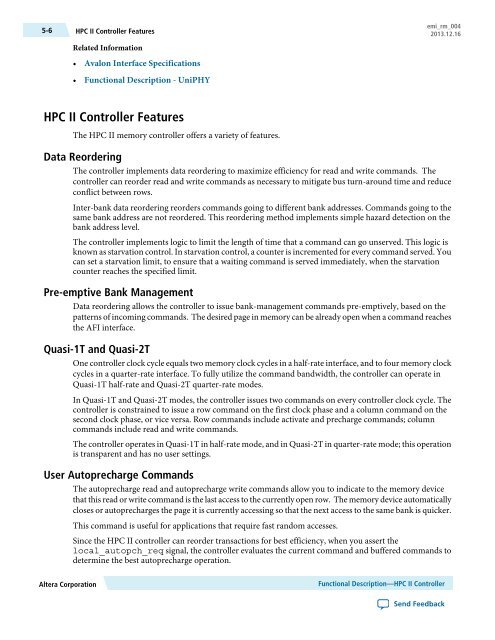Functional Description -- HPC II Controller, External Memory ... - Altera
Functional Description -- HPC II Controller, External Memory ... - Altera
Functional Description -- HPC II Controller, External Memory ... - Altera
You also want an ePaper? Increase the reach of your titles
YUMPU automatically turns print PDFs into web optimized ePapers that Google loves.
5-6<br />
<strong>HPC</strong> <strong>II</strong> <strong>Controller</strong> Features<br />
Related Information<br />
• Avalon Interface Specifications<br />
• <strong>Functional</strong> <strong>Description</strong> - UniPHY<br />
emi_rm_004<br />
2013.12.16<br />
<strong>HPC</strong> <strong>II</strong> <strong>Controller</strong> Features<br />
The <strong>HPC</strong> <strong>II</strong> memory controller offers a variety of features.<br />
Data Reordering<br />
The controller implements data reordering to maximize efficiency for read and write commands. The<br />
controller can reorder read and write commands as necessary to mitigate bus turn-around time and reduce<br />
conflict between rows.<br />
Inter-bank data reordering reorders commands going to different bank addresses. Commands going to the<br />
same bank address are not reordered. This reordering method implements simple hazard detection on the<br />
bank address level.<br />
The controller implements logic to limit the length of time that a command can go unserved. This logic is<br />
known as starvation control. In starvation control, a counter is incremented for every command served. You<br />
can set a starvation limit, to ensure that a waiting command is served immediately, when the starvation<br />
counter reaches the specified limit.<br />
Pre-emptive Bank Management<br />
Data reordering allows the controller to issue bank-management commands pre-emptively, based on the<br />
patterns of incoming commands. The desired page in memory can be already open when a command reaches<br />
the AFI interface.<br />
Quasi-1T and Quasi-2T<br />
One controller clock cycle equals two memory clock cycles in a half-rate interface, and to four memory clock<br />
cycles in a quarter-rate interface. To fully utilize the command bandwidth, the controller can operate in<br />
Quasi-1T half-rate and Quasi-2T quarter-rate modes.<br />
In Quasi-1T and Quasi-2T modes, the controller issues two commands on every controller clock cycle. The<br />
controller is constrained to issue a row command on the first clock phase and a column command on the<br />
second clock phase, or vice versa. Row commands include activate and precharge commands; column<br />
commands include read and write commands.<br />
The controller operates in Quasi-1T in half-rate mode, and in Quasi-2T in quarter-rate mode; this operation<br />
is transparent and has no user settings.<br />
User Autoprecharge Commands<br />
The autoprecharge read and autoprecharge write commands allow you to indicate to the memory device<br />
that this read or write command is the last access to the currently open row. The memory device automatically<br />
closes or autoprecharges the page it is currently accessing so that the next access to the same bank is quicker.<br />
This command is useful for applications that require fast random accesses.<br />
Since the <strong>HPC</strong> <strong>II</strong> controller can reorder transactions for best efficiency, when you assert the<br />
local_autopch_req signal, the controller evaluates the current command and buffered commands to<br />
determine the best autoprecharge operation.<br />
<strong>Altera</strong> Corporation<br />
<strong>Functional</strong> <strong>Description</strong>—<strong>HPC</strong> <strong>II</strong> <strong>Controller</strong><br />
Send Feedback
















